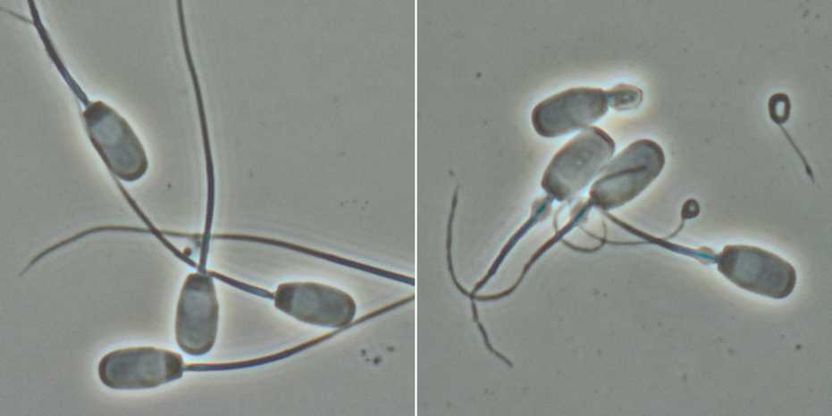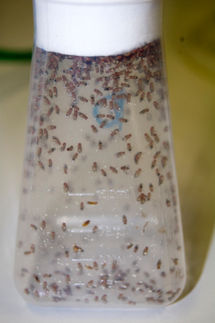Unusual mutation causes defective sperm in boars
ETH researchers have found a gene mutation that causes the sperm of boars to immobilize
In pig farming, natural mating between a boar and a sow has become rare. It is much more common for sows to be artificially inseminated. This is more efficient and facilitates the breeding of pigs with desirable characteristics.

Normal sperm (l.) and those with curved tails that cannot move.
zVg Hubert Pausch/ETH Zürich
Before sows can be artificially inseminated, veterinarians must first obtain ejaculate from boars. They then examine it in detail, looking at factors such as sperm concentration, sperm motility or ejaculate volume. After inserting semen into a breeding sow, the veterinarians also record whether the insemination was successful.
Boars with sperm defects
It was during this kind of routine ejaculate screening that scientists noticed something odd about five breeding boars of the breed “Swiss Edelschwein”: the sperm obtained from them was unusable. Under the microscope, the veterinarians saw that the sperm were not mobile because their tails were shortened and crooked. Such defects, which occur sporadically in livestock but also in humans, are often the result of changes in genes.
In the case of these boars, however, it wasn’t clear which gene mutation was stunting their sperm.
Mutation traced
In collaboration with colleagues from the Vetsuisse Faculty at the University of Zurich, ETH researchers led by livestock genomicist Hubert Pausch sequenced the entire genome of the five boars and compared it with that of healthy animals. This ultimately enabled the researchers to track down the mutation underlying the sperm defect:
It affects a gene that is the blueprint for a protein involved in building the sperm tail. The mutation causes a defect in production of the protein in question, leading to proteins that are too short and thus not functional. As a result, the sperm tail cannot form correctly.
An unusual place for a mutation
“From a genetic point of view, this mutation is unusual,” Pausch says. It affects a gene sequence that is non-coding, which is to say it doesn’t contain any information for the construction of the protein itself. Rather, this sequence is a control element that is needed to correctly cut the RNA transcript of the gene and reattach the loose ends. The mutation leads to a defective transcript, which in turn means dysfunctional proteins are synthesised.
But because this mutation occurs at an unusual site, it wasn’t obvious to the researchers when they began their search. Pausch says that there are only a handful of studies worldwide showing similar DNA changes in livestock.
Thanks to these new findings, pig farmers can now have breeding boars specifically tested for this mutation. At first this might sound like a superfluous examination, since deformed sperm can actually be seen under the microscope.
But there’s a catch: like humans, pigs have a double set of chromosomes, one maternal and one paternal. This means all genes are present in duplicate. If the mutation affects only one copy of the gene, that boar’s sperm tails remain unaffected and the genetic defect goes unnoticed. Only if both copies of the gene have the same mutation does it have a negative effect on the corresponding trait. Geneticists call this recessive inheritance.
Genetic testing lets farmers identify early on which boars and sows within the herd have at least one “bad” copy of the gene. To prevent the mutation from spreading further, these animals are then no longer used for breeding.
Reducing problems of inbreeding
This genetic defect accumulates as a result of inbreeding, which causes recessive mutations to become more often phenotypically visible in a population. One of the breeding goals is to reduce this frequency. However, eliminating all recessively inherited defects altogether is not feasible: “Our genomic analyses show that there are hundreds of potentially fatal mutations in a wide variety of genes in breeding lines. Getting all of these down to zero is impossible,” Pausch says.
The study was conducted in collaboration with the Department of Reproductive Medicine at the Animal Hospital of the University of Zurich and Suisag, a service company for the Swiss pig industry.




















































